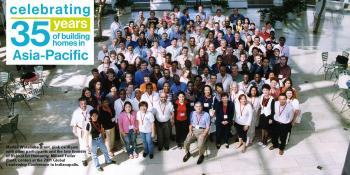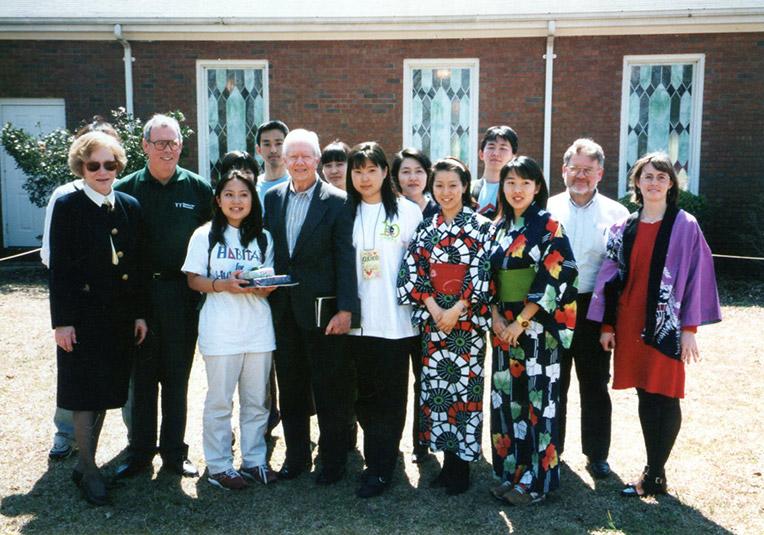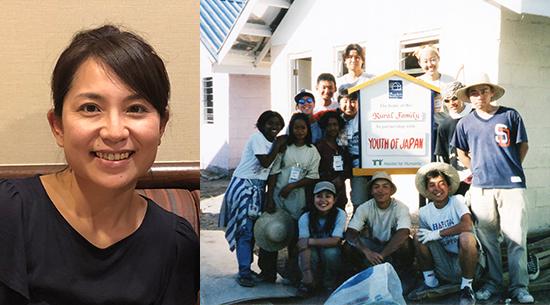
Why I volunteer
Mariko Watanabe was a high school student in the U.S. when she first volunteered with Habitat for Humanity. She credits several people including Habitat’s founders Millard and Linda Fuller for her two decades of support. Now Mariko, 41, is based in Japan as a contract staff member sending Habitat volunteer teams from the country to builds around the Asia-Pacific region. In an email interview, she shares why everyone can play a part in helping families secure a decent place to live.

Now: (from left) Mariko Inokuchi, Mariko Watanabe and Yukari Jacobson, the first president of Habitat Japan’s campus chapter at Kwansei Gakuin University Uegahara. Then: Mariko Watanabe (far right) with Mariko Inokuchi and Faith Fuller. All photos courtesy of Mariko Watanabe.
1. When did you first get involved with Habitat for Humanity Japan?
It was the summer of 1997 when I was a sophomore at Kyoto University of Foreign Studies. I participated in my very first Global Village build at a work site in Bacolod, the Philippines. Another student, Mariko Inokuchi, or Mariko Asano as she was known then, and one of our college professors, Craig Smith, joined the GV team from Kwansei Gakuin University Uegahara Campus. A few years earlier, I had some experience volunteering at a Habitat construction site in Syracuse, New York, when I was studying at one of the local high schools outside the city. I really enjoyed helping to build houses.
When I heard about the GV trip to the Philippines during Craig’s class, something just clicked in my mind, and I remembered that I was very excited to find out about the way to work with Habitat again outside of the U.S. When we came back from our first GV trip, we accomplished the establishment of Habitat’s Campus Chapter in our university.
There was no Habitat for Humanity office in Japan back then. After I graduated from college, I started working as a Global Village coordinator with Habitat’s Japan Support Office in January 2001. The number of GV participants from Japan had kept growing, so Habitat for Humanity International decided to establish an office in Tokyo to support those GV volunteers departing from Japan. I was there until the summer of 2004.
2. Did anyone influence your decision to work with Habitat? Tell us more about the person.
With regard to the establishment of our Campus Chapter, it was professor Craig Smith from my university, and Rick Hathaway, who was regional director of Habitat’s East and Southeast Area Regional Office at that time. They had always acknowledged our activities and contributions to Habitat, even when it was just a small thing. And they had always encouraged us to believe in ourselves to keep moving forward.
As for officially working with Habitat, I would definitely add Habitat founders Millard and Linda Fuller, and their daughter Faith to the list.
I was very lucky to visit churches in different cities in Japan with Millard and Linda Fuller, and their daughter Faith, to raise awareness of the need for decent housing, and spread the word about Habitat. It was between 1997 and 1999. By listening closely to their eloquent and powerful speeches, I got more and more involved in the work of Habitat. In my senior year, I remember that Craig Smith advised me to write an e-mail to Millard directly, telling him that I was very much interested in working with Habitat after my graduation. Millard wrote back soon after and Rick Hathaway gave me a chance for a job interview later that year.

In 1999, Mariko (second from left) met Habitat’s most famous volunteers, former U.S. President Jimmy Carter and his wife Rosalynn, after attending his Sunday School class at a church in Georgia.
3. As a volunteer, how did you contribute to Habitat?
As Habitat’s Campus Chapter members, we continuously worked to raise awareness of the need for decent housing in school and outside, and spread the word about Habitat to other universities and high schools. We also raised funds to donate to local Habitat affiliates in other countries when we went on GV builds.
4. Why did you support Habitat Japan instead of another nonprofit organization?
First of all, I always find it pleasant to help others in need.
Secondly, I myself love to help build houses. My father had done the foundation work on his own house. My brother is a carpenter and I always love helping them at the construction site.
Finally, having the chance to meet the founder of Habitat for Humanity and listening closely to his words had a huge impact on my life. Furthermore, I had a chance to personally meet with former U.S. President Jimmy Carter and his wife Rosalynn after attending his Sunday School class at his hometown church in Georgia. (I think it was during my spring break in 1998.)
I thought all those things are meant to lead me to serve Habitat for Humanity any way I can.

Mariko (left) feels that volunteers should have a first-hand experience of poverty and inadequate housing. In the photo on the right, Mariko (front row, left) joined Japanese and Filipino volunteers at the 1999 Carter Work Project in the Philippines.
5. Please share about your most memorable experience with Habitat. What makes it so special?
It was the 1999 Carter Work Project in the Philippines, the first such project to be held in Asia. There were hundreds and thousands of volunteers from all walks of life getting together at the same time, helping to build homes with those in need. I flew in to the Philippines a few weeks prior to the project and helped with volunteer registration. By taking part in such a magnificent project and witnessing everyone’s efforts and love, it made me want to help more people to have this great experience. That project led me to work with Habitat Japan as a GV coordinator.
6. Are you still involved with Habitat Japan? In what ways?
I am currently working as a contract GV coordinator sending volunteer teams from Japan. I started the job in June this year, and I have sent four GV teams to Cambodia, Indonesia, and the Philippines this summer.
I am very excited that the number of GV volunteers departing from Japan is still growing, and more and more youths are spreading the word about Habitat in and outside of Japan.
7. What would you tell a person who is thinking of volunteering or donating or supporting Habitat Japan?
If it’s possible, go and see, and face the poverty, in disaster-stricken areas, or any other place where help is needed. Talk to the people facing problems and make it personal, at least while you are there. When you take it personally, any size of contribution will make the world a better place to live.
8. Habitat’s vision is of a world where everyone has a decent place to live. Do you think that can be achieved? Why?
I’m afraid that it can’t be achieved 100 percent; I think there will always be yet another family who is in need of safe, affordable housing. But we can definitely move closer to the goal by building homes for families, one home at a time. There will always be a need, and that’s why we need to keep working.
9. What can a volunteer do to help Habitat fulfill its vision?
Keep raising awareness of the need for safe, affordable housing around the world and try to encourage people around you to join the work of Habitat.
Find out more about Habitat’s work and our supporters through our e-newsletter, Asia-Pacific Update. Subscribe now.